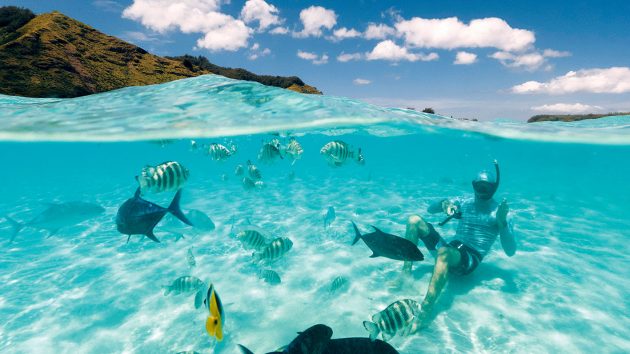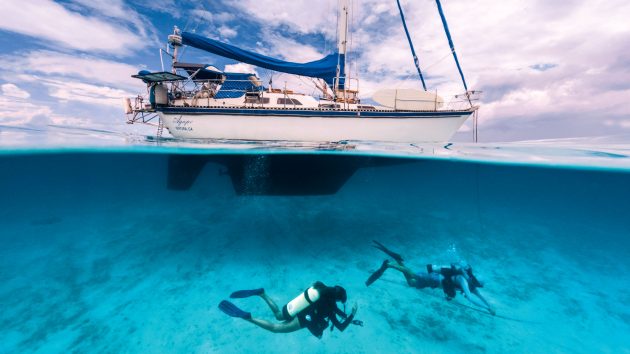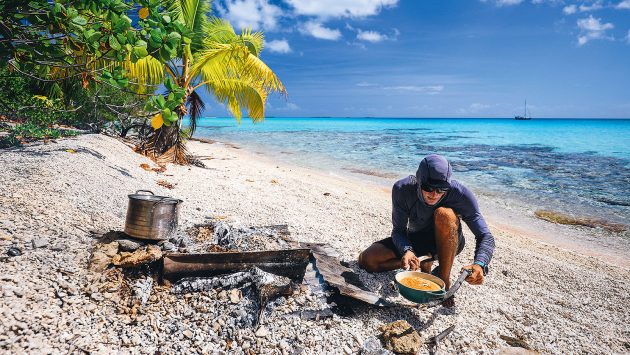Joshua Shankle and Rachel Moore’s first long-haul voyage takes them to French Polynesia where they explore stunning landscapes and remote atolls
Many sailors dream of setting off for a Pacific crossing with warm tropical trade winds blowing across the stern creating a beautiful 3,000 mile milk run.
This exotic South Pacific fantasy is typically filled with lush islands, flower-crowned dancers moving hypnotically to the gentle beat of a ukulele, and the sweet scent of tiare blossoms billowing in the breeze.
For years we have worked to turn this dream into reality. My wife, Rachel, and I spent two years sailing the Pacific Coast from our home port of Ventura, California to Mexico and through Central America to Panama.
We slowly built our confidence and tweaked our Tayana Vancouver 42, Agape, preparing to cross the Pacific Ocean.
Exploring the wild coast of Central America allowed us to sail in extremely diverse conditions, from rainstorms with over 40 knots of wind to perfect spinnaker races.
We managed to encounter virtually every type of sailing, anchoring and sailing we thought we might encounter in the remote islands of the South Pacific.
Our crossing was uneventful, and although painfully slow at times, it was one of the best sailing experiences we’ve had to date. We encountered the full gamut of weather conditions, from heavy gusts that lasted for hours to an ocean so calm it mirrored the sky.
As expected, we had good trade wind sailing for most of our trip, and even with Agape grossly overloaded with fuel and supplies, we managed to do our best 24-hour run of 166 miles.
After 27 days of endless blue and constant motion, the excitement on board was tangible. We could see land and our chart plotter finally read an ETA of hours, not days. It felt like we were ready to burst with a multitude of emotions.
We trimmed our sails, trying to squeeze as much speed as possible out of our 34 year old sailboat, eager to enter the protected Gambier lagoon and finally cast off the hook in French Polynesia!
As our anchor plunged into the clear, turquoise water, all of the hard work, sacrifice and struggle it took to bring this cruising dream to life suddenly felt insignificant.

It was love at first sight. We immediately fell in love with French Polynesia, not only for its natural beauty, both above and below the water, but also for its
a rich history, people and culture.
Underwater worlds in French Polynesia
Located over 800 miles south-southeast of the Marquesas Islands and 900 miles from Tahiti, the local name Mangareva roughly translates to “separate or remote people”.

Being so far from the capital city of Papeete has kept the most pernicious effects of Western influences at bay, and upon making landfall here, the feeling of separation is palpable.
This small archipelago is made up of five large volcanic islands and 18 smaller islets protected by a great barrier reef. While the hiking and snorkeling here is phenomenal, we found learning about the local pearling industry to be the highlight.
Gambier is famous for its production of Tahitian black pearl and its waters are teeming with oyster farms. There are so many that navigating them can be a challenge. Long lines, supported by floats just below the surface of the water, suspend millions of oysters in the vast majority of the lagoon.
Rachel and I visited several farms during our six week stay, learning how oysters are farmed and pearls are created. We watched the pearls being seeded and harvested from the oysters, and trying as best we could to avoid temptation, we were captivated by the rich luster of these little gems and ended up with a little treasure on board.

As the season changed, we found ourselves a bit too far south. When the coconut oil in our cupboard started to solidify, we knew it was time to continue our journey into warmer waters.
About 400 miles of marvelous trade wind sailing, on a northwesterly course, are the low islands that had filled my dreams for years – the Tuamotus.
The 76 ancient volcanic calderas that make up this archipelago have all but been swallowed up by the sea. Most are only a few meters above sea level, with palm trees vying for position in an otherwise endless blue horizon. .
Dubbed the Dangerous Archipelago, it’s often sailors’ first experience with strong currents, maneuvering through narrow passes and anchoring in coral-filled lagoons.
The accuracy of modern maps and GPS has made navigation here much safer, although not entirely reliable. For this reason, I have spent a good number of hours at the bow or even sitting on the lower spreaders as a lookout, to help Rachel successfully navigate the lagoon and sneak into some truly spectacular anchorages. .

The Paumotu people who inhabit these islands are warm and welcoming. Although this is French territory, it is worth remembering that the people here are Polynesian and learning a little of their language guarantees a warm welcome.
We often found ourselves in bounty battles as we offered fishing gear, solar lights or other items, and in return we would be blessed with lobster, coconut crabs or beautifully presented fish.
These islands are where Robinson Crusoe’s dreams come true. Many are barely inhabited, if at all, and cruisers can easily find secluded anchorages where days or weeks can pass.
For the sporty sailor, a plethora of wind and water sports await. Surfing, kitesurfing, scuba diving and spearfishing in the warm, crystal clear waters here provide the perfect playground to hone your skills or learn new ones.
The lure of tranquility
After spending several months enjoying the vast underwater world of the Tuamotus, we were thrilled to finally set sail for Tahiti and the Society Islands.

Commercial hub of French Polynesia, Tahiti is the land of plenty. Marine supplies and large, well-stocked grocery stores abound in the ever-increasing bustle of a modern metropolis. The juxtaposition of the industrial port of Pape’ete and the surrounding landscape is striking.
While most boats use Tahiti to stock the pantry, make any necessary repairs, and get medicals before proceeding, this island shouldn’t be rushed.
Tahiti offers cultural sites, world-class diving, hiking and surfing – including the renowned surf spot, Teahupo’o. And while there are enough unique activities to hold one’s attention for months, if not years, the tranquil appeal of the neighboring island of Mo’orea is often too hard to resist.
In an afternoon of sailing, Moorea is the pinnacle of Polynesia. Over the past three years we have spent more time anchored in its protected lagoon than any other.
It is, for us, the perfect blend of lush tropical mountains, pristine reefs and modern conveniences. We’ve spent months hiking through hills, valleys and pineapple fields and we’ve barely scratched the surface.
This island paradise is also one of the best places in the world to see migrating humpback whales, and it’s one of the few places where you can still swim with these majestic giants.
Sailing further west brings you to the leeward islands of Huahine, Raiatea, Taha’a, Bora Bora and Maupiti. Like the other islands of French Polynesia, the Sous-le-Vent are all different in their attractions and atmospheres. Our favorite, and perhaps the best kept secret in the Pacific, is Huahine.

Often referred to as a sacred or isolated island, it is one of the few to have resisted the influx of tourism. The vanilla-scented breeze is almost as intoxicating as the relaxed, leisurely pace of life here. There are several mooring fields and large anchorages in the large protected lagoon.
Below the surface we found the water full of vibrant corals, anemones and colorful reef fish. Back on land, the island is famous for its historical sites, unique ancient fish traps and sacred blue-eyed eels.
Hiring a bike, if you don’t have one on board, is a great way to get off the boat, stretch your legs and experience the beauty of this haven at a more appropriate pace.
Even after three years of drifting around this Pacific playground, the spell cast by these Polynesian waters still holds on. Agape and his crew. We were lucky enough to wait out these turbulent times of the pandemic in such a pristine paradise.
While we await the reopening of the borders of the island nations to the west, we look forward to exploring the two remaining archipelagos of the Marquesas and the Australs. These idyllic islands will continue to captivate us until we can continue our world tour.
Advice for a cruise in French Polynesia
With the hurricane season defined between November and March, most of the 400 yachts departing from the Americas will transit from mid-March to early April.

If you hold a British passport, you do not need a visa to enter French Polynesia for stays of up to three months, but you must check with the French Ministry of Foreign Affairs (www.france-visas.gouv.fr) for long stays.
The majority of boats cross French Polynesia with a three-month tourist visa. Sadly, the days of simply hoisting a sail and letting the winds and sea be your guide are over.
Today, cruising involves a lot more bureaucracy and paperwork. To be approved for a temporary resident visa, also known as a residence card, you need to start the paperwork long before you set off across the Pacific.
The hassle of obtaining this visa is well worth the time and meager expense involved, as it gives you the most valuable resource: time. With so many islands to explore and activities to do, this visa, when duly renewed, can allow you to stay in French Polynesia for several years.
Many of our favorite islands and anchorages are well off the beaten track in already remote and remote territory. Although not absolute, it is important that boats traveling here are relatively self-sufficient.
Having solar panels or wind turbines, a watermaker and plenty of stores for spare parts and food on board is a good idea, as supply ships transporting goods to many outlying islands can sometimes take weeks or months, and stocks may be scarce.
Did you enjoy this read?
A subscription to Yachting Monthly magazine costs about 40% less than the cover price.
Print and digital editions are available through Magazines Direct – where you can also find the latest offers.
YM is packed with information to help you get the most out of your time on the water.
-
-
- Take your seamanship to the next level with tips, advice and skills from our experts
- Unbiased in-depth reviews of the latest yachts and equipment
- Cruising guides to help you reach those dream destinations
-
follow us on Facebook, Twitter and Instagram.

